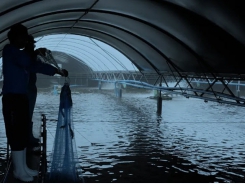Sub-Saharan African aquaculture sector challenged by feed accessibility

Sub-Saharan Africa’s aquaculture production, estimated at 1.7 million metric tons (MT) of the global 76.6 million MT of production in 2015, continues to face fish feed shortages.
Those shortages have dimmed hopes of the sector’s growth in response to the region’s increasing population – now estimated at one billion people.
According to an African Union report, stumbling blocks constraining the growth of the region’s aquaculture to its full potential include “challenges in the supply and access to key inputs notably, feed, seed, human resources, appropriate technology and finance.”
Although the existing aquafeed manufacturing capacity in sub-Saharan Africa and the regional demand cannot be determined precisely, there is an increasing concern that a lack of local access to quality fish feeds – which has consigned the region into an import-reliant market – could hamper efforts to scale up transformation of aquaculture in the region.
In Tanzania, where an estimated 3,400 MT of fish is produced – 85 percent of it tilapia – aquaculture farmers rely on fish feed imports from Egypt, Mauritius, The Netherlands, Zambia, and Kenya.
“However, due to high tax barrier, farmers suffer a high cost of production,” according to a report by the Aquaculture Association of Tanzania.
Some of the region's aquaculture farmers produce their own fish feed at an estimated cost of USD 1.30 (EUR 1.44) per kilogram, but the report said this feed is usually “powdery and un-floating pellets.” The farmers formulate the fish-feed utilizing locally-produced plant grains such as cassava flour, rice bran, maize bran, and cotton seed cakes, but the feeds “are still too costly for small farms to be profitable.”
In Zambia, the Food and Agriculture Organization (FAO) reports the sector is underexploited because of inadequate capacity to generate adequate quality fingerlings and fish feeds. The landlocked country – which has attracted investments in aquaculture inputs and feed manufacturing from Aller Aqua, Horizon Aquaculture, and Skretting that progressed the development of fish feed milling and input supply facilities – produced an estimated 26,800 MT of fish – 90 percent of it tilapia – from aquaculture in 2017. However, the country’s aquaculture potential is projected to grow to 40,000 MT at least by 2023, according to the Global Aquaculture Alliance.
In Nigeria – sub-Saharan Africa’s biggest aquaculture producer with an estimated production of 340,000 MT, 95 percent of it catfish – some investment has also been made in the country’s fish feed milling facilities by Aller Aqua and Singapore-based Olam International.
Both Kenya and Uganda are producing floating (extruded) pellets to serve the East African market.
“There is also a variety of local feed manufacture solutions, especially in the less-productive aquaculture countries, ranging from farmer-formulated meal-type diet to a quasi-pellet produced with a grinder and subsequent drying to form water-soluble, hard, sinking pellets,” FAO says.
But across the African continent, the majority of Africa’s feed needs are being met by farm-made feeds, rather than industry-produced formulas, according to the University of Lilongwe’s Department of Agriculture and Natural Resources.
“The aquaculture sector relies on farm-made feeds while feed manufactured by the formal industry accounts for less than 20 percent in most of the countries except in Egypt, Nigeria, Ghana, Mauritius, Zimbabwe, Zambia, Malawi, Uganda, and other fast-growing aquaculture countries,” the university said in a report.
FAO expressed optimism in the growth of sub Saharan Africa’s aquafeeds manufacturing capacity, especially with the progress of expansion in feed milling capacity in Ghana, Kenya, Nigeria, Uganda, and Zambia.
It could be the shortages of fish feed is providing an opportunity for would-be investors in aquafeed manufacturing to invest in sub-Saharan Africa, especially in countries where governments have agreed to address the high cost of energy, taxation of project equipment, and access to foreign exchange, the FAO added.
The main challenge for sub-Saharan Africa’s aquafeed, the organization said in its report, is how the region will address the existing need “for research and technology development, in particular the development of high-quality, cost-effective aquafeeds designed specifically for species and life-stages being grown, profitability or viability of different aquaculture production systems, subsequent development of business plans, and value-chain improvement, marketing, and research to inform policy.”
Có thể bạn quan tâm
Phần mềm

Phối trộn thức ăn chăn nuôi

Pha dung dịch thủy canh

Định mức cho tôm ăn

Phối trộn phân bón NPK

Xác định tỷ lệ tôm sống

Chuyển đổi đơn vị phân bón

Xác định công suất sục khí

Chuyển đổi đơn vị tôm

Tính diện tích nhà kính

Tính thể tích ao hồ



 Shrimp exports to EU suffer plunge in ten…
Shrimp exports to EU suffer plunge in ten…  Japanese tech firm secures CP shrimp farm deal…
Japanese tech firm secures CP shrimp farm deal…